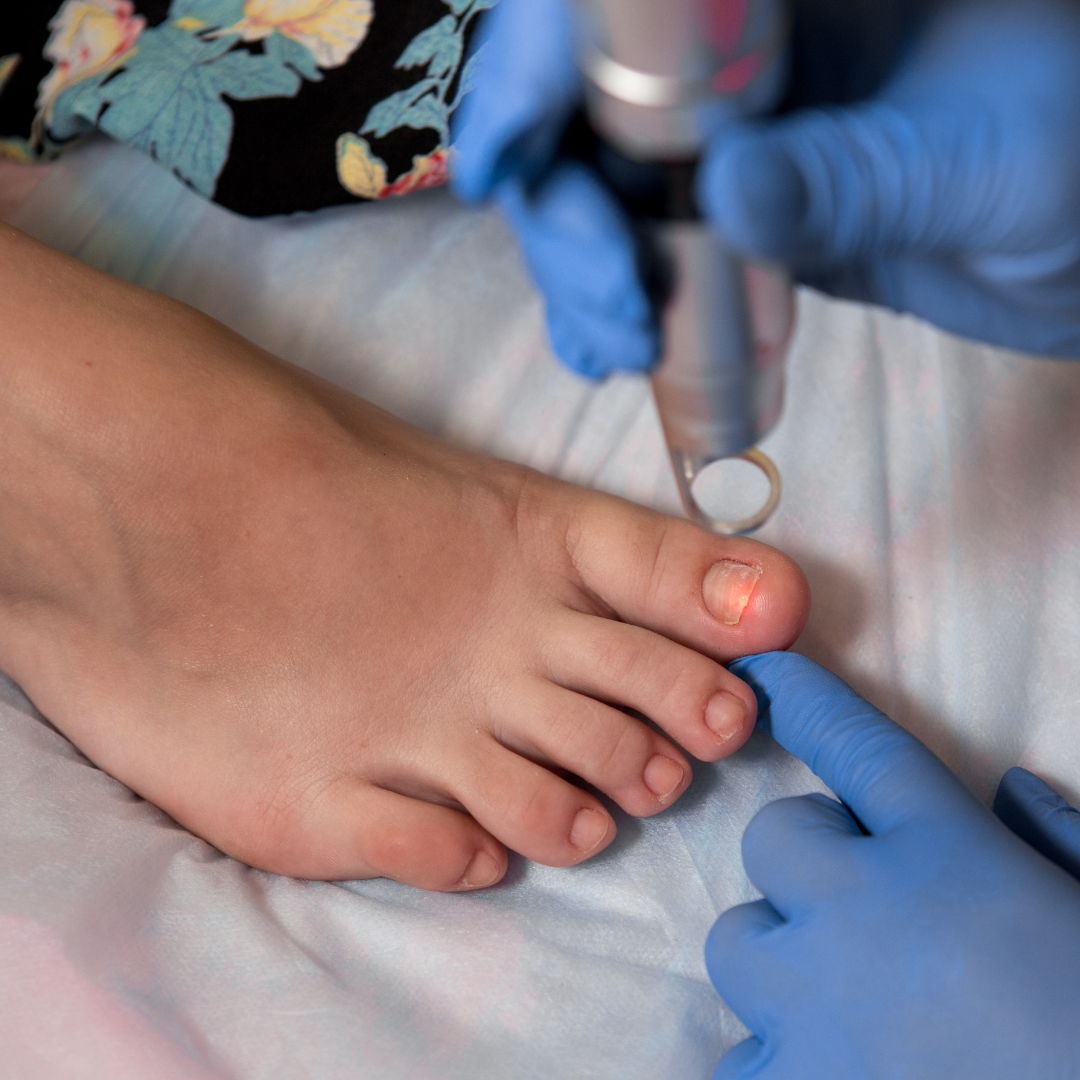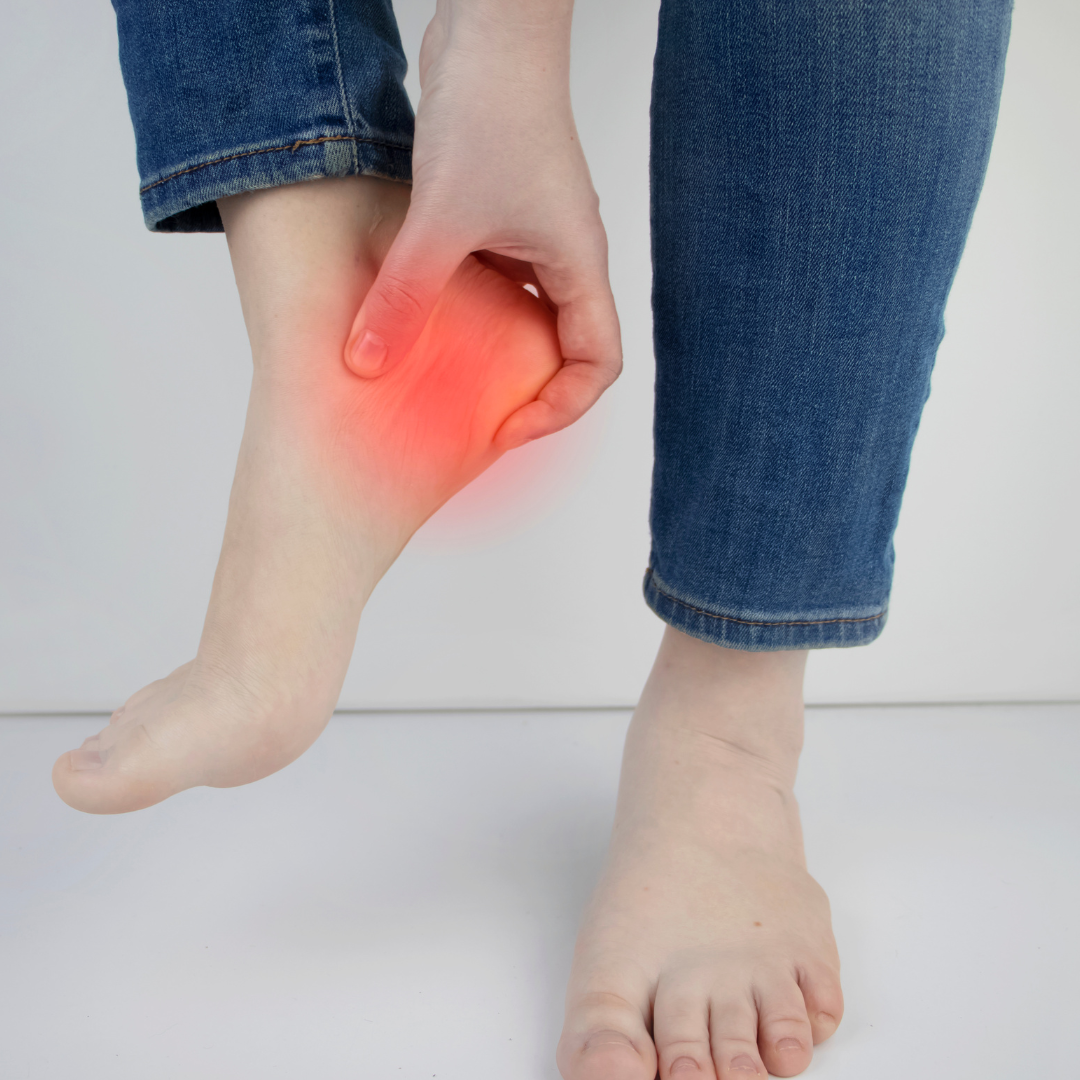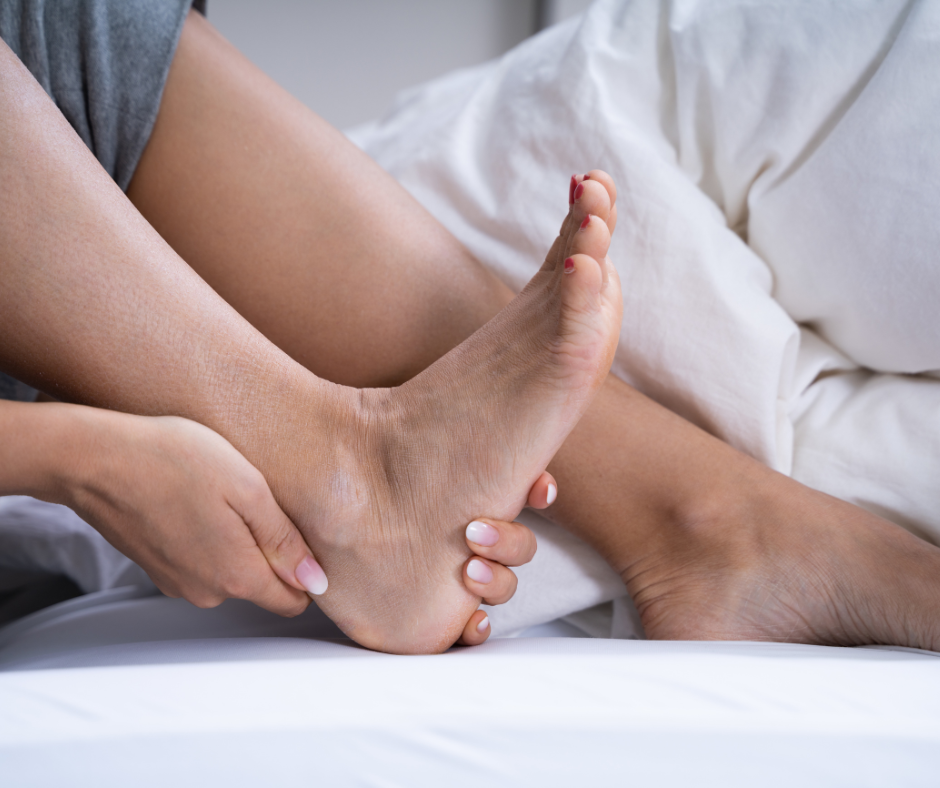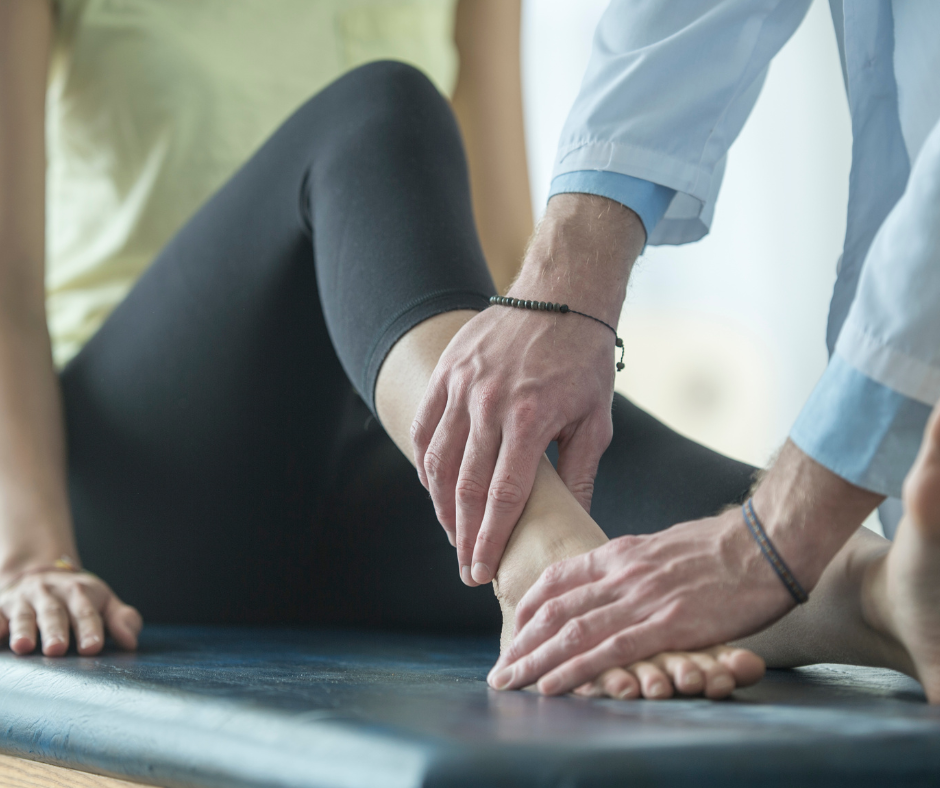-
5 Ways Physical Therapy Makes For Fitter Feet!
Kentlands Foot & Ankle Center understands the value of conservative treatments and natural remedies; in fact, Dr. Sherman was featured in Business Insider a few months ago discussing just that! It should come as no surprise, then, that our team places such a high value on the power of physical therapy, which can make a difference for a wide range of lower extremity ailments.
This blog will cover five different conditions and circumstances that PT alleviates, improves, or even prevents. Let’s kick things off!
- Plantar Fasciitis:
This prevalent problem inflicts heel pain due to inflammation of the plantar fascia, the tissue connecting your heel to your toes. Physical therapists can design personalized plantar fasciitis stretches with a custom program that improves flexibility, reduces pain, and prevents future flare-ups.
- Ankle Sprains:
Rolled ankles are frequent, painful injuries, stretching or tearing the ligaments that stabilize your joints. Physical therapy can provide an ankle sprain recovery regimen and ankle strengthening exercises to help you regain range of motion, strengthen supporting muscles, and improve proprioception (your body’s awareness of joint position). This, in turn, will reduce pain, swelling, and the risk of future sprains.
- Achilles Tendinitis:
Overuse can inflame the Achilles tendon, causing pain in the back of your heel. Physical therapy focuses on reducing inflammation, improving flexibility, and strengthening the calf muscles to better support the tendon.
- Arthritis:
Both osteoarthritis and rheumatoid arthritis can affect the foot and ankle joints, leading to pain, stiffness, and reduced mobility. Physical therapists can create an exercise program to maintain joint mobility, strengthening surrounding muscles while improving balance. This helps manage pain, maintain function, and potentially delay the need for surgery.
- Post-Surgical Recovery:
After foot or ankle surgery, physical therapy is crucial for regaining strength, flexibility, and range of motion. A personalized program helps restore proper gait mechanics and function, ensuring a smooth and successful recovery.
As you can see, physical therapy can do all kinds of good for your feet and ankles, healing them when they’re hurt and maintaining them when they’re fit.
Interested in learning more? We’re always available and happy to help! Schedule a comprehensive foot examination with Kentlands Foot and Ankle Center podiatrist Dr. Jon M. Sherman. To make your appointment, please call our office at 301-330-5666.
-
Keep Your Feet Flowing: Blood Flow and Circulation in the Lower Extremities

February is American Heart Month, a timely reminder to prioritize our cardiovascular well-being. However, while most focus remains on the heart itself, its connection to our feet and lower extremities tends to go unnoticed.
The truth is that healthy blood flow and circulation are crucial for happy, healthy feet. Let the team at Kentlands Foot & Ankle Center delve into this vital relationship for you! Together, we’ll explore how to keep your feet flowing freely.
Heart Health Basics
Your heart pumps tirelessly and constantly, sending oxygen-rich blood throughout your body. But that doesn’t mean there aren’t any problems.
- In terms of distance, your heart works hardest to send blood to your feet, which are as far away from it as possible.
- When this intricate system functions well, your feet receive the nutrients they need to stay healthy and function optimally.
- When something goes amiss, your feet are typically the first to find out.
When the Flow Filters
Disruptions to your circulation tend to translate into problems for your feet.
- Conditions like peripheral artery disease (PAD) – which affects nearly 34 million Americans – narrow arteries, restricting blood flow to the lower extremities.
- This can lead to symptoms such as pain, numbness, and even tissue damage in severe cases.
Circulation Education
Fortunately, several measures can promote healthy blood flow and circulation in your feet:
- Regular exercise, including walking, improves circulation throughout your body, including your lower extremities.
- Avoid tight shoes that constrict blood vessels in your feet.
- If you have diabetes or high blood pressure, work with your doctor to manage these conditions effectively.
- Consult a podiatrist promptly for any concerns like pain, numbness, or changes in skin color or texture.
When in doubt, it never hurts to consult a DPM with a proven reputation for knowing how to handle all kinds of foot and ankle complications!
Schedule a comprehensive foot examination with Kentlands Foot and Ankle Center podiatrist Dr. Jon M. Sherman. To make your appointment, please call our office at 301-330-5666.
-
An Ounce of Prevention is Worth a Pound of Cure with Diabetes

When it comes to the diabetes epidemic, podiatrists are on the front lines. That’s why an expert DPM knows better than most that diabetes can seriously harm your feet. Recent statistics paint a troubling picture: The CDC asserts that nearly 39 million people, or 11.6 percent of the US population, currently have diabetes, with almost 9 million of those as yet undiagnosed. Millions more are pre-diabetic, and that number only becomes grimmer as people age.
Individuals with diabetes are at a higher risk of developing foot complications like neuropathy, poor circulation, and foot ulcers. From there, problems can get even worse. That’s why podiatric care is essential for anyone managing this disease. Check out a few of the helpful tips below, courtesy of Kentlands Foot & Ankle Center.
If you’re a diabetic, see a podiatrist regularly!
- Everyone with diabetes should have an annual exam, no matter what. But for some patients, even more visits will be required.
- Medicare will permit most people to schedule an appointment every two months to care for their nails and calluses. Take advantage of that, and try to stay consistent with your efforts.
Check your feet twice a day!
- Look for the unusual – cuts, redness, anything.
- If you see something, contact us right away.
- Don’t try to handle the problem yourself; you might risk infection or further complications.
DON’T GO BAREFOOT!
- As a diabetic, you always want to protect your feet.
- Wound healing is a dangerous issue, and even minor cuts can harm you more than you think.
- Wear shoes at all times!
Don’t let your diabetic foot care problems get out of hand. It’s important to take action right away if you notice anything amiss. We encourage residents of Montgomery County to consult Dr. Sherman sooner rather than later for a complete examination and assessment of diabetic foot health complications. Call 301-330-5666. or contact us online for an appointment at our Gaithersburg podiatry office. We look forward to getting you back on your feet and keeping you there!
-
Podiatric Medicine Brings Lasers Down To Earth

Lasers might seem like they belong in space, but they can actually be quite helpful here on the ground. At Kentlands Foot and Ankle Center, we think the therapeutic applications of lasers don’t get enough attention. With that in mind, we’ve put together a short blog post that explains just how great these high-tech systems can be from a podiatric point of view!
Laser Therapy: Fighting Fungal Toenails
- Stubborn, uncomfortable, and aesthetically unpleasant toenail fungus can recur again and again.
- We use the PinPointe laser system to penetrate the nail and exterminate fungus at the source.
- This non-invasive technique is successful, safe, and painless.
- As the first laser ever to be cleared for use by the FDA, it has a proven record of success.
Why Use Lasers?
- No drugs or side effects. Oral medications can alter liver enzymes, while topicals often take a year or more to work. Topical meds also have to be used twice a day if they’re going to have a chance at succeeding.
- They’re quick. PinPointe treatment will only take about 30 minutes.
- No recovery time or pain. The laser reaches under the nail areas without damaging the skin. You can walk in, have your treatment, and walk out on the same day. Once the fungus has been destroyed, new nail growth begins.
- Solid success rates. Many patients see perceptible improvements after just a single treatment, with clear nail growth stimulated right away.
PinPointe laser therapy is just one of many advanced medical methods we utilize at the Kentlands Foot and Ankle Center, where we’re always seeking the next innovation. In fact, we have other lasers we like to use! Different systems are employed for different purposes: We have a Remy Class IV Laser to treat issues like plantar fascitis, while Cold Laser Therapy helps with pain relief and nerve damage resulting from injuries. Lasers are a great option when you want to avoid the cost, pain, and prescription meds that go hand in hand with surgery.
A good laser can be your foot’s best friend. Come see for yourself! Dr. Jon Sherman always employs the most modern, sophisticated techniques available to offer his Gaithersburg patients top-quality podiatric care. Contact us today to schedule an appointment.
-
Running Shoes: Start Off on The Right Foot!

If you run, you need the right footwear. Fortunately, Kentlands Foot and Ankle Center is well-prepared to support your footwear needs. Before you decide which shoe is right for you, let’s break down some common tips that can improve performance and ensure sustainability.
Here are some Do’s and Don’ts to follow before purchasing new running shoes
DON’T run in old, beat-up shoes. Runners need to be prepared, and footwear is no exception. To keep shoes fresh, try to have two pairs on hand and alternate them. The wear and tear from repeated motions erodes the support of a running shoe, which might increase your risk of injury.
DO invest in a pair of good socks and laces. The right pair of socks will provide valuable cushioning and even help with sweating. Laces with ‘bumps’ along them might cost a little more, but they don’t slide around in your shoes.
DON’T ignore the unique traits of your feet. Do you have high, flat, or neutral arches? Do your ankles roll when you run? These are the kinds of details our experts can help you with, and knowing about them beforehand will help you choose the right shoes for you.
DO consider custom orthotics. These can enhance your running game by helping to prevent injuries before they occur. And we can help you find the perfect fit! At Kentlands, there are no more clunky plaster casts or lengthy waiting times. Instead, we employ our new 3D laser scanner to perform a clinical examination of your feet. In just 10 seconds, this technology takes thousands of measurements and provides the perfect custom fit.
We’re big fans of running, and we know just how much it can benefit your life. Still, putting safety first is important. Dr. Jon Sherman is an acknowledged expert in treating sports injuries, and he has served as a consultant for the Marine Corps Marathon. He’s well-equipped to help improve your athletic performance and keep your feet healthy as you chase your goals. To schedule a comprehensive foot examination with Dr. Sherman at our Gaithersburg office, please call 301-330-8971 or contact us online today.
-
Good News for People with Chronic Heel Pain!

A twitch of pain somewhere in your foot is one thing – brief and tolerable. Thank goodness it goes away.
Heel pain that doesn’t go away is an entirely different matter. We’re talking about the heel pain that greets you like a knife when you step out of bed every morning. The kind of intense pain that makes you cry out, perhaps with a few choice words you didn’t mean to say. This kind of pain requires attention from Kentlands Foot and Ankle Center’s board-certified podiatrist, Dr. Jon M. Sherman, because it’s not likely to get better on its own.
Plantar fasciitis, explained!
The medical term for chronic heel pain is plantar fasciitis. Any medical word with the suffix “-itis” means “inflammation.” In this case, it’s the plantar fascia that’s inflamed. The plantar fascia is a large, thick ligament that runs along the bottom of your foot, connecting the calcaneus (heel bone) to your toes. It’s easily inflamed under some circumstances:
- You have a job that requires you to be on your feet for much of the day, such as a waiter, nurse, or urban mail carrier.
- You’re a runner or walker who’s recently increased their mileage, pace, or distance.
- You participate in other athletic activities, such as ballet, that put a lot of stress on your feet.
- You’re carrying some extra pounds, which puts undue stress on your feet.
- You have pre-existing issues with your foot anatomy, such as flatfoot or high arches.
- You’re over 40: The older you are, the more likely you will develop plantar fasciitis.
The pain you don’t have to live with
Fortunately, we have many effective treatments that soothe the pain of plantar fasciitis. Dr. Sherman will likely start with conservative approaches, including taking a break from any activity that hurts, performing stretching exercises, icing, taking anti-inflammatory medications, wearing custom orthotics, and getting steroid injections. Often, the best treatment involves a combination of all these.
Other treatment options include non-invasive shockwave therapy (ESWT, laser light therapy/cold laser, and physical therapy. Surgery for plantar fasciitis is a possibility but not a common one.
The key to successful plantar fasciitis treatment is getting it promptly. Don’t wait. We encourage residents of Montgomery County to consult Dr. Sherman sooner rather than later for a full examination and assessment of their heel pain. Call 301-330-5666 or contact us online for an appointment at our Gaithersburg podiatry office.
-
Regular Exercise Can Prevent Falling: 5 Ways to Make It Easier

If you’re alive on this planet, you know that doctors always recommend regular exercise for optimal health. Exercise improves heart function, keeps unwanted pounds off, wards off disease, and even calms symptoms of depression and anxiety. But if you’re a senior citizen, there’s another benefit of exercise you may not have thought of:
Regular exercise can help prevent dangerous falls.
If you’re someone who exercises already – great. You’re better off than the 30-40% of people over 65 and 50% of people aged 80 and up who take a fall every year. If you don’t exercise, starting an exercise program may seem daunting. But, it doesn’t have to be.
Here are five ways to get motivated to strengthen the muscles that help you sit, stand, and walk confidently without dangerous hesitations or wobbles:
- First things first – fix your foot or ankle pain: Exercise may be difficult, painful, or downright impossible if it causes pain. Let our board-certified podiatrist, Jon M. Sherman, treat your toe arthritis, nerve pain, or plantar fasciitis with state-of-the-art treatments and therapies, including custom orthotic inserts and targeted laser therapy. Dr. Sherman can also perform a fall prevention risk assessment.
- Do something you like: Walking is easy and requires no special equipment except a great pair of shoes. If walking isn’t appealing, there’s swimming, tai chi, and yoga.
- Start slowly: You risk injuring yourself if you exercise long and hard from the get-go.
- Exercise with a friend: An exercise partner can be very helpful to keep you motivated.
- Take advantage of Montgomery County resources: Call your local senior center or YMCA to inquire about balance and exercise classes. Many facilities offer transportation to and from, making it easier to keep exercising.
Commit to exercise this Falls Prevention Awareness Month! For a foot exam or personalized fall prevention assessment, contact Kentlands Foot & Ankle Center in Gaithersburg at 301-330-5666 or request an appointment with Dr. Sherman online.
-
Swift Steps and Setbacks 3 Common Foot and Ankle Injuries in Women’s Soccer

In women’s soccer, both at the amateur and professional levels, players are prone to various foot and ankle injuries due to the dynamic nature of the sport and the repetitive stress placed on these areas during matches and training.
Here are 3 common foot and ankle injuries prevalent in women’s soccer:
1-Ankle Sprains
Ankle sprains are among the most prevalent injuries in women’s soccer. They occur when the ligaments surrounding the ankle joint are stretched or torn, usually as a result of sudden changes in direction, collisions with other players, or landing awkwardly after a jump. In amateur and professional contexts, the intensity and speed of the game can increase the risk of ankle sprains. Female players, in particular, might be more susceptible due to differences in lower limb alignment and hormonal factors affecting ligament laxity. Ankle sprains can range from mild to severe, with swelling, pain, and limited range of motion being common symptoms. Management includes the R.I.C.E. protocol (rest, ice, compression, elevation), followed by physical therapy to restore strength and stability. Preventive measures include balance training, proprioceptive exercises, and using proper footwear.
2-Achilles Tendonitis
Achilles tendonitis is another prevalent injury in women’s soccer. The Achilles tendon connects the calf muscles to the heel bone and is subjected to significant stress during sprinting, jumping, and sudden stops. Overuse and improper training techniques can lead to microtears and inflammation in the tendon. Players may experience pain, stiffness, and swelling in the back of the ankle. In the professional sphere, rigorous training schedules and frequent matches can exacerbate the risk of Achilles tendonitis. Treatment involves rest, targeted stretching and strengthening exercises for the calf muscles. In severe cases, immobilization and even surgical intervention may be necessary. Proper warm-up routines, gradual increases in training intensity, and adequate footwear can help prevent this injury.
3-Metatarsal Stress Fractures
Metatarsal stress fractures are common in women’s soccer due to the repetitive impact and running involved in the sport. These fractures occur when the bones in the forefoot (metatarsals) experience repeated strain, often from overuse without adequate rest. In both amateur and professional contexts, female soccer players can be at risk due to the high number of games and training sessions. Players with stress fractures may feel localized pain, swelling, and discomfort during activity. Treatment requires rest, often with the use of protective footwear or even a walking boot. Gradual return to play and modifications in training intensity are necessary to prevent re-injury. Ensuring proper nutrition and bone health, as well as monitoring training load, can play a crucial role in preventing metatarsal stress fractures.
Foot and ankle injuries are common in women’s soccer, both at the amateur and professional levels. Ankle sprains, Achilles tendonitis, and metatarsal stress fractures are particularly prevalent due to the demands of the sport, player-specific factors, and the intensity of training and matches. Preventive measures, including targeted exercises, adequate rest, proper warm-up routines, and attention to training load are essential to minimize the occurrence of these injuries and maintain the long-term health and performance of female soccer players.
Whether you or a member of your family have experienced an injury while participating in a sport, or leisurely walking, contact Kentlands Foot and Ankle Center podiatrist Dr. Jon M. Sherman at our Montgomery office. Please call our office today, at 301-330-5666 to schedule your appointment or visit our website.
-
Maintain A Healthy Heart
 February isn’t just for lovers. American Heart Month also reminds us to take care of our hearts and consider our risk factors. In honor of American Heart Month, our team of specialists are dedicating this post to improving heart health among our patients by sharing 5 fun activities you can participate in to maintain a healthy heart.
February isn’t just for lovers. American Heart Month also reminds us to take care of our hearts and consider our risk factors. In honor of American Heart Month, our team of specialists are dedicating this post to improving heart health among our patients by sharing 5 fun activities you can participate in to maintain a healthy heart.5 Fun Activities to Maintain a Healthy Heart
Get Moving. Looking to boost your heart health without going for a jog? Try aerobic physical activities, or opt for another cardio option like a neighborhood walk with your family. Whatever gets your body moving and your heart pumping! To get the ball rolling, here are some moderate-intensity exercises for your heart and lungs that you can do to improve heart health:
- Brisk walking
- Play Tennis
- Swim or Participate in Water Aerobics
- Join A Cycling Class
- Go On a Hike
Cuddle. Looking to reduce your stress levels? Cuddling with a pet or a loved one has been shown to reduce stress levels, which is one of the leading causes of heart disease. During American Heart Month, give your pet extra cuddles, take a walk for some aerobic physical activity, or adopt a furry friend. Your heart and theirs will definitely appreciate it!
Have A Piece of Dark Chocolate Before Bedtime. There is a study showing that all kinds of chocolate may help lower your risk of heart problems. If dark chocolate is your favorite sweet treat, you’re in luck. Dark chocolate contains less sugar, a higher ratio of cocoa, and more antioxidants. Eating a piece of dark chocolate may even help you balance your cholesterol!
Have A Good Laugh. When was the last time you laughed so hard, you began to tear-up? There is research showing the greater your sense of humor is, the lower the risk you have of developing heart disease. Laughing at humorous things also helps battle against distressing emotions like depression, anxiety, and anger, all of which increase the likelihood of heart problems. The saying “Laughter is the best medicine” truly does hit home with this heart healthy activity.
Don’t Skip Breakfast. Breakfast can be the most common meal of the day to skip. We have all had those early mornings with no energy or appetite. A study of over 4,000 participants found that those who get less than five percent of their daily calories from breakfast (100 of the 2,000 recommended for women) were more likely to have clogged and damaged arteries than those who eat a high-energy breakfast (over 400 calories for women). So grab your fresh fruit, whip up some eggs, and improve your heart health with a tasty breakfast every day!
Schedule a comprehensive foot examination with Kentlands Foot and Ankle Center podiatrist, Dr. Jon M. Sherman, at our Montgomery office. To schedule your appointment, please call our office at 301-330-5666.
-
Let This Year Be The End Of Your Foot Pain

As we welcome the new year, many feel motivated to take steps towards self-improvement. Some may begin by improving their daily routines, including increased healthy exercise habits. If you start a new fitness routine, be gentle with yourself, be consistent, and start slowly. Occasionally, heel pain can intensify when you begin a new exercise routine. Don’t let heel pain prevent you from moving forward with your 2023 fitness goals!
Heel pain (plantar fasciitis) may be one of the most common issues seen by podiatrists today. It’s a condition in which the band of tissue that stretches from your heel bone to your toes becomes inflamed, torn, or otherwise stressed from overuse. It is vital to get a complete exam and proper diagnosis if you experience heel pain.
Our specialists recommend using the following methods to resolve foot pain during the new year
- Follow simple stretches and exercise routines to strengthen the foot.
- Wear proper fitting shoes with arch and ankle support.
- Ice your heel several times a day to reduce uncomfortable inflammation.
- Rest your lower extremities.
- Use custom orthotics to alleviate chronic foot pain.
- Use an anti-inflammatory drug such as Ibuprofen and Naproxen to help with the pain.
- Call a podiatrist.
Certain people have an increased risk of developing plantar fasciitis or foot pain. Those people are:
- Between the ages 40-60
- Carry extra weight
- Have predisposed hereditary conditions
- Have tight Achilles tendons
- Wear non-supportive shoes or high heels
- Have an occupation that causes you to be on your feet for extended periods
The longer you have been experiencing the pain of plantar fasciitis, the longer it may take to help resolve the pain. To better determine the source of your heel pain and the best course of treatment, schedule a comprehensive foot examination with Kentlands Foot and Ankle Center podiatrist, Dr. Jon M. Sherman, at our Montgomery office. To schedule your appointment, please call our office at 301-330-5666.
RECENT POSTS
categories
- Uncategorized
- Featured Articles
- Foot Disorders
- Broken Ankle
- Broken Toe
- Fracture
- Foot Health
- Foot Care
- Arthritis
- Foot Pain
- Skin Cancer
- Podiatry Appointment
- Custom Orthotics
- Podiatrist
- Diabetes
- Gout
- Heart Health
- National Nutrition Month
- National Foot Health Awareness Month
- Foot Safety
- Foot and Ankle Injuries
- Falls Prevention
- Chronic Heel Pain
- Shoes
- Laser Therapy
- Quoted
- Physical Therapy
- KeryFlex
- Sweat
- Summer Foot Care
- Sports Injury
- ESWT
- Fungal Toenails
- Bunion
- Plantar Fasciitis
- PinPointe Laser
- Heel Pain



